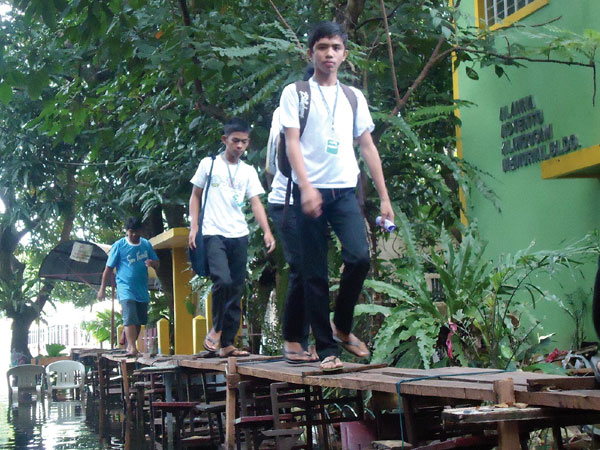
STUDENTS cross bamboo bridges to reach their classrooms on the second floor of the inundated Siniloan National High School in Siniloan, Laguna. MARY ANN LEOPANDO/CONTRIBUTOR
SINILOAN, Laguna—Students and teachers of Siniloan National High School (SNHS) in Siniloan town in Laguna must carefully cross improvised bamboo bridges from the campus gates to the second floor of their building to reach their classrooms.
Floodwaters brought about by heavy monsoon rains since early this month have continued to submerge the school grounds and most of the 41 classrooms on the ground floor.
Only 10 classrooms on the second floor have been spared to accommodate all the students, according to guidance counselor Melina Vista. As a result, some 120 students from two or three sections are cramped into one classroom instead of the ideal ratio of 45:1, she said.
Classes are conducted in shifts. Students in the higher sections attend classes from 6:30 a.m. to 5 p.m. and those in the lower sections, from 7 a.m. to 5 p.m. Grades 7 and 8 students hold classes on Mondays, Tuesdays and Wednesdays, while Grades 9 and 10 students hold classes from Thursdays to Saturdays.
An elevated stage of the covered court was even used as a classroom, Vista said.
With a total student population of 2,206, the school is also beset by absenteeism, said Mary Ann Leopando, a senior bookkeeper.
Teacher Marjorie Mendez said the three sections of students in second year total 169, but only 58 are able to attend classes regularly. Those extremely affected by the floods are living near the Laguna lake and in nearby Pangil and Pakil towns, which have been cut off from Siniloan by deep and stagnant floods.
The highway connecting Pangil and Pakil to Siniloan is submerged, so students have to take only the road from Famy town and pay double the fare.
One student, Wenalyn Lizo, 14, of Barangay Wawa, no longer goes to school because she cannot afford to pay P10 for a banca ride.
The stagnant floodwaters have started to emit foul odor from dead fish floating.
A few days before the Inquirer visited the school, one of the teachers, Rico Mejia, 34, contracted leptospirosis after dipping into the floodwater while helping construct the bamboo bridge.
Leopando said only one comfort room is being used by the 73 faculty members.
The condition is much worse in the elementary building annex, she said. “The evacuees have literally converted the floodwaters as their comfort rooms because of inadequate CRs (comfort rooms).”

